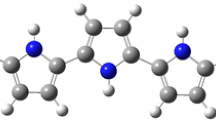Abstract
The mechanisms of chemical dedoping of conductive polypyrrole with the initial conductivity values differing by an order of magnitude have been studied using EPR spectroscopy. An analysis of the temperature dependences of the electrical resistance of the initial highly conductive samples and dedoped samples has revealed a transition from three-dimensional conduction in the initial samples to one-dimensional conduction in the dedoped samples. This transition is caused by the transformation of transverse bipolarons into longitudinal bipolarons and ipolarons. It has been established that transverse and longitudinal quasiparticles are stabilized by counterions involving iron ions in different spin states: the spin of iron in the counterion of a transverse bipolaron is 2 and iron is inactive in the EPR spectrum, whereas in the counterion of longitudinal quasiparticles, the spin of iron is 5/2 and iron becomes paramagnetic.
Similar content being viewed by others
References
O. A. Andreeva, L. A. Burkova, M. A. Smirnov, and G. K. El’yashevich, Polym. Sci., Ser. B 48(6), 331 (2006).
N. Mott, Conduction in Non-Crystalline Materials (Clarendon, Oxford, 1993).
M. N. Bussac and L. Zuppiroli, Phys. Rev. B: Condens. Matter 49, 5876 (1994).
L. Zuppiroli, M. N. Bussac, S. Paschen, O. Chauvet, and L. Forro, Phys. Rev. B: Condens. Matter 50, 5196 (1994).
J. A. Reedijk, H. C. F. Martens, and H. B. Brom, Phys. Rev. Lett. 83, 3904 (1999).
J. Fink, B. Scheerer, W. Wernet, M. Monkenbusch, G. Wegner, H. J. Freund, and H. Conska, Phys. Rev. B: Condens. Matter 34, 1101 (1986).
M. A. Smirnov, N. V. Bobrova, Z. Pientka, and G. K. El’yashevich, Polym. Sci., Ser. B 47(7–8), 215 (2005).
A. T. Burkov, A. Heinrich, P. P. Konstantinov, T. Nakama, and K. Yagasaki, Meas. Sci. Technol. 12, 264 (2001).
J. A. Walker, L. F. Warren, and E. F. Witucki, J. Polym Sci. A: Polym. Chem. 26, 1285 (1988).
M. P. Hendrich and P. G. Debrunner, Biophys. J. 56, 489 (1989).
J. Typek, N. Guskos, E. Filipek, and M. Piz, Rev. Adv. Mater. Sci. 23, 196 (2010).
J. M. Gaite, P. Ermakoff, Th. Allard, and J. P. Moller, Clays Clay Miner. 45, 496 (1997).
H. Rager and H. Scheneider, Am. Mineral. 71, 105 (1986).
I. Petrov and S. S. Hafner, Am. Mineral. 73, 97 (1988).
Author information
Authors and Affiliations
Corresponding author
Additional information
Original Russian Text © O.A. Andreeva, L.A. Burkova 2011, published in Fizika Tverdogo Tela, 2011, Vol. 53, No. 9, pp. 1826–1831.
Rights and permissions
About this article
Cite this article
Andreeva, O.A., Burkova, L.A. EPR study of the mechanism of chemical dedoping of conducting polypyrrole. Phys. Solid State 53, 1927–1932 (2011). https://doi.org/10.1134/S1063783411090022
Received:
Published:
Issue Date:
DOI: https://doi.org/10.1134/S1063783411090022




